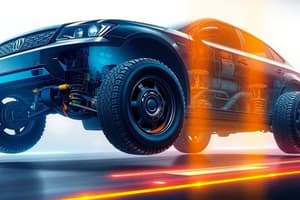Podcast
Questions and Answers
What is the primary function of springs in a suspension system?
What is the primary function of springs in a suspension system?
- To control spring oscillations
- To reduce friction and wear between moving parts
- To absorb bumps and maintain vehicle ride height (correct)
- To connect the suspension to the vehicle frame
What type of suspension system is known for being simple and cost-effective?
What type of suspension system is known for being simple and cost-effective?
- Rigid Axle Suspension (correct)
- Semi-Independent Suspension
- Independent Suspension
- MacPherson Strut Suspension
What is the purpose of ball joints in a suspension system?
What is the purpose of ball joints in a suspension system?
- To allow for pivoting movement (correct)
- To connect the suspension to the vehicle frame
- To maintain vehicle ride height
- To absorb bumps and vibrations
What is the benefit of a suspension system in terms of safety?
What is the benefit of a suspension system in terms of safety?
What type of shock absorber uses electrical signals to control damping?
What type of shock absorber uses electrical signals to control damping?
What is the purpose of struts in a suspension system?
What is the purpose of struts in a suspension system?
What is the benefit of a suspension system in terms of comfort?
What is the benefit of a suspension system in terms of comfort?
What component of a suspension system reduces friction and wear between moving parts?
What component of a suspension system reduces friction and wear between moving parts?
Flashcards are hidden until you start studying
Study Notes
Components of a Suspension System
- Springs: absorb bumps and maintain vehicle ride height
- Types:
- Coil springs
- Leaf springs
- Torsion bars
- Types:
- Shock Absorbers (Dampers): control spring oscillations and maintain vehicle stability
- Types:
- Hydraulic shock absorbers
- Gas-filled shock absorbers
- Electronic shock absorbers
- Types:
- Struts: combination of spring and shock absorber in one unit
- Control Arms: connect suspension to vehicle frame, allowing for up and down movement
- Bushings: reduce friction and wear between moving parts
- Ball Joints: connect control arms to steering knuckles, allowing for pivoting movement
Types of Suspension Systems
- Rigid Axle Suspension: simple and cost-effective, used in older vehicles
- Independent Suspension: each wheel moves independently, providing better handling and ride quality
- Types:
- Double Wishbone Suspension
- MacPherson Strut Suspension
- Multi-Link Suspension
- Types:
- Semi-Independent Suspension: combines elements of rigid axle and independent suspension
Functions of a Suspension System
- Supports vehicle weight
- Absorbs bumps and vibrations
- Maintains vehicle ride height
- Improves handling and stability
- Reduces body roll and pitch
Importance of a Suspension System
- Safety: improves vehicle stability and handling, reducing risk of accidents
- Comfort: provides a smooth ride, reducing fatigue and discomfort
- Performance: enhances vehicle handling and responsiveness
- Durability: reduces wear and tear on vehicle components
Components of a Suspension System
- Springs absorb bumps and maintain vehicle ride height, and come in three types: coil springs, leaf springs, and torsion bars
- Shock Absorbers (Dampers) control spring oscillations and maintain vehicle stability, and come in three types: hydraulic, gas-filled, and electronic
- Struts combine spring and shock absorber functions in one unit
- Control Arms connect suspension to vehicle frame, allowing for up and down movement
- Bushings reduce friction and wear between moving parts
- Ball Joints connect control arms to steering knuckles, allowing for pivoting movement
Types of Suspension Systems
- Rigid Axle Suspension is a simple and cost-effective system used in older vehicles
- Independent Suspension allows each wheel to move independently, providing better handling and ride quality
- Independent Suspension has three types: Double Wishbone, MacPherson Strut, and Multi-Link
- Semi-Independent Suspension combines elements of rigid axle and independent suspension
Functions of a Suspension System
- Supports vehicle weight
- Absorbs bumps and vibrations
- Maintains vehicle ride height
- Improves handling and stability
- Reduces body roll and pitch
Importance of a Suspension System
- Ensures safety by improving vehicle stability and handling, reducing the risk of accidents
- Provides comfort by giving a smooth ride, reducing fatigue and discomfort
- Enhances vehicle performance by improving handling and responsiveness
- Increases durability by reducing wear and tear on vehicle components
Studying That Suits You
Use AI to generate personalized quizzes and flashcards to suit your learning preferences.




